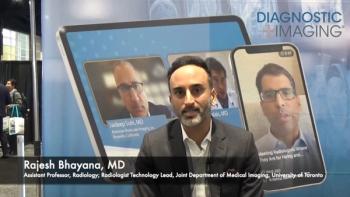
Fuji to debut chest CR unit at RSNA meeting
Fuji Medical Systemsis moving to diversify its line of computed radiography productswith the introduction of FCR 9501, a dedicated upright imagingunit. Fuji plans to showcase the product at this month's RadiologicalSociety of North America meeting. FCR
Fuji Medical Systemsis moving to diversify its line of computed radiography productswith the introduction of FCR 9501, a dedicated upright imagingunit. Fuji plans to showcase the product at this month's RadiologicalSociety of North America meeting.
FCR 9501 represents an evolution from Fuji's FCR 7501 uprightCR reader while offering the same features as FCR 9000, accordingto John Strauss, marketing manager for CR products. FCR 9000 isthe company's fifth-generation CR reader introduced last year(SCAN 2/2/94).
While FCR 9000 is a general-purpose unit, FCR 9501 is intendedfor upright exams such as chest studies. The unit also supportsother types of exams such as cervix, upright abdomen, hip andweight-bearing ankles or knees. Due to several design changes,FCR 9501 is capable of imaging patients in wheelchairs or on gurneys.
FCR 9501 can process 105 14 x 17-inch plates or 120 14 x 14-inchplates an hour, a slightly faster throughput in the 14 x 17 formatthan the FCR 9000. The list price of FCR 9501 will be in the samerange as the FCR 9000, which is priced at $325,000. Fuji has Foodand Drug Administration clearance for the reader and is readyto begin shipping products.
The system is designed to compete with automatic screen-filmchest units manufactured by Siemens, Picker and GE, Strauss said.Fuji will also experience competition from Philips, which receivedFDA clearance for its ThoraVision chest CR system in September(SCAN 10/12/94).
In addition to FCR 9501, Fuji plans to highlight several otherrecent developments in computed radiography, such as its dynamicrange control (DRC) set of image processing algorithms, whichare still works-in-progress. Fuji will also unveil a new advancethat improves the spatial resolution of CR so dramatically thatit will answer critics of the technology, Strauss said.
"There will be a significant breakthrough in CR imageresolution," Strauss told SCAN. "Since the inceptionof CR there has been the issue of CR being inferior in spatialresolution to film. This will quiet those people."
Newsletter
Stay at the forefront of radiology with the Diagnostic Imaging newsletter, delivering the latest news, clinical insights, and imaging advancements for today’s radiologists.




























